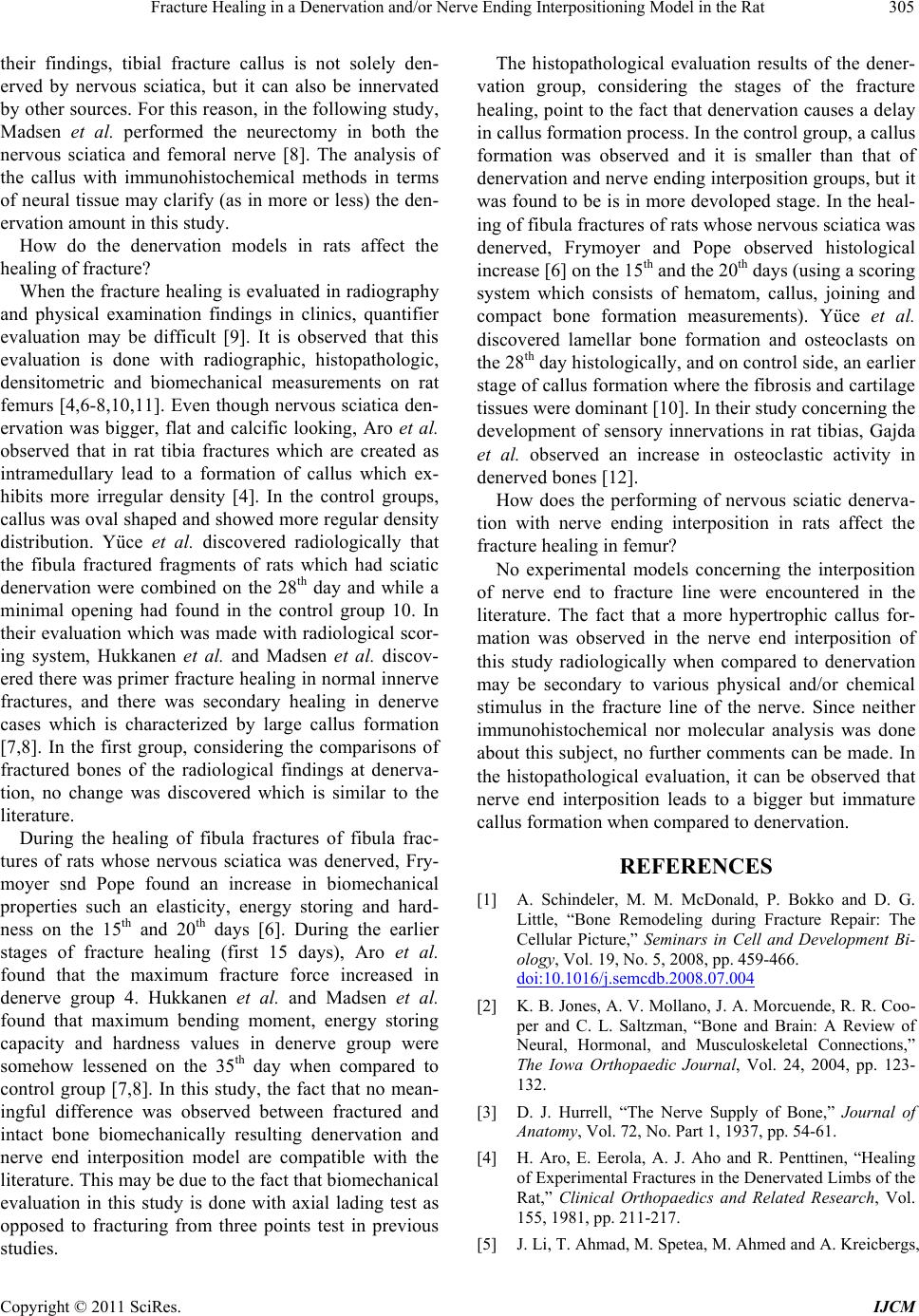
Fracture Healing in a Denervation and/or Nerve Ending Interpositioning Model in the Rat 305
their findings, tibial fracture callus is not solely den-
erved by nervous sciatica, but it can also be innervated
by other sources. For this reason, in the following study,
Madsen et al. performed the neurectomy in both the
nervous sciatica and femoral nerve [8]. The analysis of
the callus with immunohistochemical methods in terms
of neural tissue may clarify (as in more or less) the den-
ervation amount in this study.
How do the denervation models in rats affect the
healing of fracture?
When the fracture healing is evaluated in radiography
and physical examination findings in clinics, quantifier
evaluation may be difficult [9]. It is observed that this
evaluation is done with radiographic, histopathologic,
densitometric and biomechanical measurements on rat
femurs [4,6-8,10,11]. Even though nervous sciatica den-
ervation was bigger, flat and calcific looking, Aro et al.
observed that in rat tibia fractures which are created as
intramedullary lead to a formation of callus which ex-
hibits more irregular density [4]. In the control groups,
callus was oval shaped and showed more regular density
distribution. Yüce et al. discovered radiologically that
the fibula fractured fragments of rats which had sciatic
denervation were combined on the 28th day and while a
minimal opening had found in the control group 10. In
their evaluation which was made with radiological scor-
ing system, Hukkanen et al. and Madsen et al. discov-
ered there was primer fracture healing in normal innerve
fractures, and there was secondary healing in denerve
cases which is characterized by large callus formation
[7,8]. In the first group, considering the comparisons of
fractured bones of the radiological findings at denerva-
tion, no change was discovered which is similar to the
literature.
During the healing of fibula fractures of fibula frac-
tures of rats whose nervous sciatica was denerved, Fry-
moyer snd Pope found an increase in biomechanical
properties such an elasticity, energy storing and hard-
ness on the 15th and 20th days [6]. During the earlier
stages of fracture healing (first 15 days), Aro et al.
found that the maximum fracture force increased in
denerve group 4. Hukkanen et al. and Madsen et al.
found that maximum bending moment, energy storing
capacity and hardness values in denerve group were
somehow lessened on the 35th day when compared to
control group [7,8]. In this study, the fact that no mean-
ingful difference was observed between fractured and
intact bone biomechanically resulting denervation and
nerve end interposition model are compatible with the
literature. This may be due to the fact that biomechanical
evaluation in this study is done with axial lading test as
opposed to fracturing from three points test in previous
studies.
The histopathological evaluation results of the dener-
vation group, considering the stages of the fracture
healing, point to the fact that denervation causes a delay
in callus formation process. In the control group, a callus
formation was observed and it is smaller than that of
denervation and nerve ending interposition groups, but it
was found to be is in more devoloped stage. In the heal-
ing of fibula fractures of rats whose nervous sciatica was
denerved, Frymoyer and Pope observed histological
increase [6] on the 15th and the 20th days (using a scoring
system which consists of hematom, callus, joining and
compact bone formation measurements). Yüce et al.
discovered lamellar bone formation and osteoclasts on
the 28th day histologically, and on control side, an earlier
stage of callus formation where the fibrosis and cartilage
tissues were dominant [10]. In their study concerning the
development of sensory innervations in rat tibias, Gajda
et al. observed an increase in osteoclastic activity in
denerved bones [12].
How does the performing of nervous sciatic denerva-
tion with nerve ending interposition in rats affect the
fracture healing in femur?
No experimental models concerning the interposition
of nerve end to fracture line were encountered in the
literature. The fact that a more hypertrophic callus for-
mation was observed in the nerve end interposition of
this study radiologically when compared to denervation
may be secondary to various physical and/or chemical
stimulus in the fracture line of the nerve. Since neither
immunohistochemical nor molecular analysis was done
about this subject, no further comments can be made. In
the histopathological evaluation, it can be observed that
nerve end interposition leads to a bigger but immature
callus formation when compared to denervation.
REFERENCES
[1] A. Schindeler, M. M. McDonald, P. Bokko and D. G.
Little, “Bone Remodeling during Fracture Repair: The
Cellular Picture,” Seminars in Cell and Development Bi-
ology, Vol. 19, No. 5, 2008, pp. 459-466.
doi:10.1016/j.semcdb.2008.07.004
[2] K. B. Jones, A. V. Mollano, J. A. Morcuende, R. R. Coo-
per and C. L. Saltzman, “Bone and Brain: A Review of
Neural, Hormonal, and Musculoskeletal Connections,”
The Iowa Orthopaedic Journal, Vol. 24, 2004, pp. 123-
132.
[3] D. J. Hurrell, “The Nerve Supply of Bone,” Journal of
Anatomy, Vol. 72, No. Part 1, 1937, pp. 54-61.
[4] H. Aro, E. Eerola, A. J. Aho and R. Penttinen, “Healing
of Experimental Fractures in the Denervated Limbs of the
Rat,” Clinical Orthopaedics and Related Research, Vol.
155, 1981, pp. 211-217.
[5] J. Li, T. Ahmad, M. Spetea, M. Ahmed and A. Kreicbergs,
Copyright © 2011 SciRes. IJCM